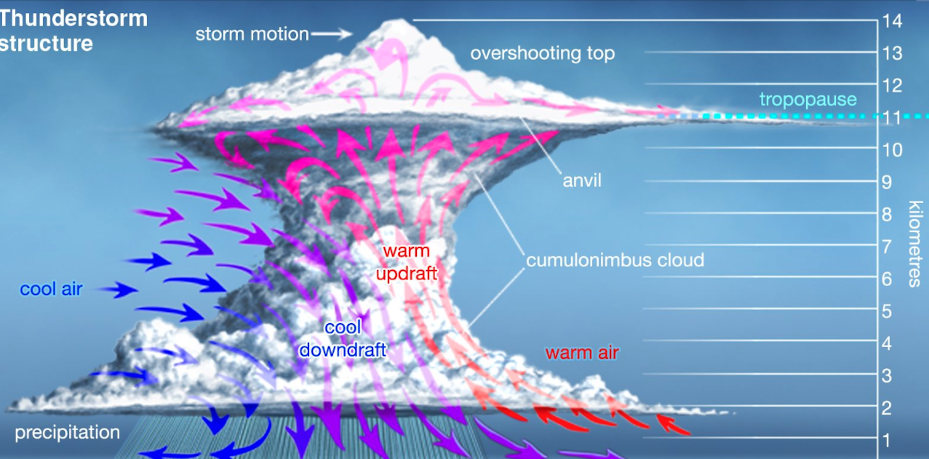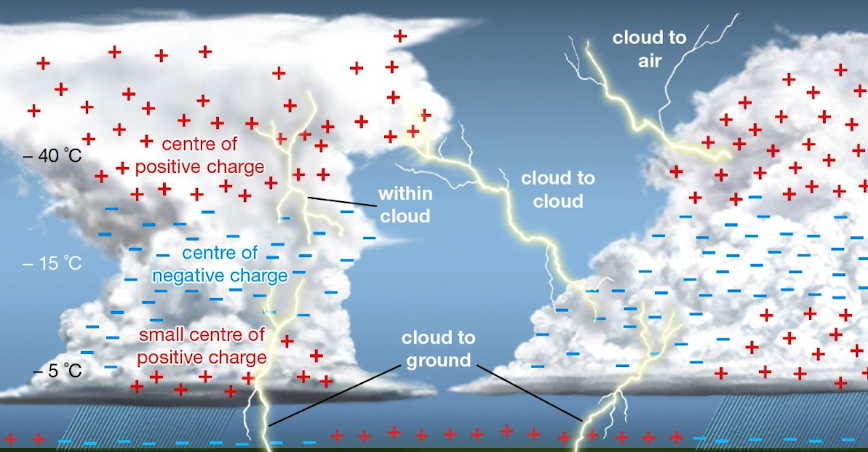I didn’t really want to write this, but there is so much confusion about lightning protection I think I need to. Yay, an explainer video! I stole the cloud pictures (and corrected my faulty understanding of charge generation from Encylopedia Britannica. Wikipedia and web resources are cool, but Britannica is Britannica.
Lightning starts off as a electrically charged cloud where positive and negative charges within the cloud get separated. Small ice crystals get carried up by updrafts, while soft hail (called graupel, no I don’t know why) drifts downward. Collisions between rising ice crystals and falling graupel result in charge transfer by a mechanism called non-inductive charging, which I’m not going to explain, which occurs during collisions under specific conditions. So the ice crystals become positively charged and are carried to the top of the cloud, while graupel becomes negatively charged at lower parts of the cloud. It reminds me of the rotating belt of Van de Graf electrostatic generators, which every nerd back in the ’60s (including me) built for science fair, though mine was part of a linear accelerator that I eventually was not permitted to run or even plug in during the fair. But my Van de Graf stored it’s charge in a 20 inch ball, while thunderclouds are a bit bigger. Like millions of times bigger. Of course there are other details, but that’s close enough. Positive on top, negative on the bottom.

That strong negative charge at the bottom of the cloud, deep in the megajoules, induces a positive charge on the earth in a relatively small area under it. It’s all about potential difference, as we’ll soon see, and when it gets big enough some weird shit happens. A negative discharge ionizes the air, making it conductive, and this odd discharge called a “stepped leader” extends downward from the cloud. When it gets within about 100 meters from the ground it induces upward “streamers” or “leaders” from tall objects like trees or buildings. These streamers carry positive charges upward. When the stepped leader and the upward streamer meet, maybe 100 meters above the ground, a conducting channel is formed and all hell breaks loose. Negative charges stream down the conductive path and then the big boy–the return stroke flows positive charge upwards and blows shit to pieces. The air around the plasma channel heats to about 30,000 degrees C, about the temperature of the photosphere around the sun, and makes a shock wave we call thunder. Is this cool or what?

A brief digression: A lot of folks talk about electricity like it’s electrons, flowing at close to the speed of light through conductors. Nope. Doesn’t happen, though electrons can move pretty fast in a vacuum if they are accelerated by an external force (hence cathode ray tubes, x-ray machines, and teenage nerd linear accelerators). Electrons have both mass and charge. They are attracted to everything, and bump into everything. Yeah, I know, that isn’t really what happens but as soon as I mention quantum effects everyone is going to bail. So no. They just bump into stuff, and move very slow, like less than 1 millimeter per second. What moves fast is the electromagnetic waves, which edge pretty close to the speed of light. End of digression.
So we have a lighting bolt which is cranking a super fast rise time in free air, and a wave in the ground, spreading out from the area where the lightning bolt originated. Both are staggeringly powerful, but both are still subject to physics, and the amount of energy is rapidly diminishing, roughly as the square of the distance for the wave being transmitted through the ground which is a point source, and a bit slower for the pulse spreading from the lightning in air, which is a line source.
And here’s your solar equipment, sitting there fat, dumb, and happy about 1000 yards from the lighting bolt. The racks and frames are a nice antenna, soaking up that pulse in the air, turning the EM wave into current. But hey, you have a local ground, so even though you also have a path into the equipment ground, which we should call PE, the least resistance is straight to that earth ground, so it’s gone. Yay.
But you also have two earth grounds, and the ground wave is traveling along between them. It hits the first and then reaches the second. The earth ground is fairly high resistance, so the voltage between them is a ratio of the resistance between the ground rods to the resistance from the the point of origin to the furthest ground rod. No big deal if the bolt voltage were a few hundred volts, but when its millions of volts, it’s a very big deal. Current would flow from the highest potential to the lowest–LOTS of current. And yes, it’s just current in the ground conductors, but don’t forget that forms electro-magnetic waves that induce current in every conductor nearby. Your sensitive electronics are toast. Even unconnected electronics will get a big pulse induced into them, and if they don’t have some basic protection they are now only good as doorstops.
But wait, you trenched between your ground rods and installed some bare copper #6AWG wire connecting them all. The resistance between your ground rods is less than an ohm. There’s no huge voltage drop across that low resistance, so not much voltage and hardly any current, maybe. That all depends on how close and how powerful the strike was. Too close and too powerful and all bets are off. Not because lightning is magic, but simply because even the very low resistance of a wire becomes significant when the ground wave is millions of volts. Which it can be if the strike is close or very powerful. And the voltage induced directly in your equipment from the EM radiating from the bolt itself can be more than enough to slag all the active components in the gear. Heck, if you’re standing close enough to the bolt you’ll feel the induced current in the saltwater-filled bag you call your body–maybe to the degree that you’ll slag your active components.
Some folks who commented on my previous posts picture the ground as fully charged so nothing can be dissipated to ground. That’s the wrong way to think about it. First, the lightning strike is a local phenomenon that spreads out in a hemisphere, and therefore weakens quickly according to the good ol’ inverse square law. The entire earth isn’t charged by a lightning strike–at least not at the macro level. But even if it were, electrical current flows when there is a difference in potential. Binding the ground rods together eliminates most of the difference between them. There’s still some–the wire has some resistance, so there’s a voltage drop, but the voltage and the resulting current that flows through your system should be well within the capabilities of your system to tolerate. Almost all electronics that plugs into a wall socket has some sort of surge protection, if only inherently in how the power supply works. If they didn’t, they would be dying all the time. Grid power can be noisy. Your utility doesn’t clean up spikes from neighboring sources or the inductive load of your ancient AC that cycles on and off.
So what about surge protection devices (SPDs). Well, they certainly help with input/output surges. They work by sitting quietly on the input to your device until a voltage spike appears, then they short it to ground, sort of. The technical term is clamping, meaning they conduct like crazy when the voltage reaches some amount your equipment can probably survive–like 600 Volts, and then stop conducting when the voltage drops below that trigger level, maybe. The notion that they don’t work at all because the earth ground is swarming with charge is simply the wrong mental picture. The voltage that triggers the SPD is the differential to ground, not some absolute value with no plane of reference. If ground were at some high voltage (compared to what??) and the input and output conductors were at the same voltage the SPD wouldn’t trigger, but there also wouldn’t be any damage, because with no differential voltage there’s no current flow.
The value of SPDs in dealing with lightning, solar flares, and EMP from nuclear attacks is limited. The rise time of lightning spikes is very fast. Most good SPDs have MOV’s, perhaps avalanche diodes, and some kind of fuse. Metal Oxide Varistors (MOVs) are pretty fast. Surges can be faster–but not faster than Avalanche Diodes. So some SPDs have both, MOVs to handle the bulk of the spike, diodes to handle the leading edge, and then fuses because MOVs can and do fail either open or shorted, and a shorted MOV might do a “halt and catch fire” sort of thing.
Solar flares are different. The last big one was about 11 years ago, so we’re due for another–like probably June 2025. So you can expect a marketing blitz selling ineffective protection, if only because it feels better than advertising EMP protection to preppers that they will still have an inverter after armaggedon. With a moneyback guarantee if their inverter is damaged by a nearby nuclear bomb. So they’ve got that going for them.
Solar flares have taken down grids before, mainly because they can saturate transformers. This video is getting too long so I’m not going to dig deep into the mechanism, though it is fascinating. Maybe once the blitz starts I’ll do a video on why SPDs can’t really do much and how it’s probably not your problem.
Anyway, this is getting too long, If there’s something more you’d like to hear about all this let me know in the comments. Or if you think I’m clueless then please correct me. I’m absolutely capable of being wrong.
